Side Menu:
Second Officer C.H.Lightoller
- Port Side Evacuation
Shortly after midnight, Captain Smith, realising the severity of the collision and subsequent damage, orders the officers to uncover the lifeboats, swing them out and get passengers wearing lifebelts. Chief Officer Wilde is ordered to muster the deck crew and uncover the boats.
Lightoller recalls the moment at the British Inquiry: "I met the Chief Officer almost immediately after, coming out of the door of the quarters. First of all the Chief Officer told me to commence to get the covers off the boats. I asked him then if all hands had been called, and he said, 'Yes.'" (24.)
The subsequent evacuation of the lifeboats is divided between First Officer Murdoch on the starboard side and Second Officer Lightoller on the port side. Lightoller in turn gave an order: "I got hold of the bosun's mate and sort of showed him with my hands that I wanted him to start the men stripping off the boat covers." (BBC, 1936)
Lightoller's Lifeboats:
|
Lifeboat Number |
Time Launched |
Approximate occupants |
|
Lifeboat 8 |
01:00 am |
25 |
|
Lifeboat 6 |
01:10am |
24 |
|
Lifeboat 16 |
01:20am |
52 |
|
Lifeboat 14 |
01:25am |
40 |
|
Lifeboat 12 |
01:30am |
42 |
|
Lifeboat 4 |
01:50am |
42 |
|
Collapsible D |
02:05am |
20 |
According to his book "the Titanic was fitted with a well-known pattern of davit called the 'Wellin.' (sic) In operation it was merely a matter of shipping and manning the handles of the davits, and the boats were quickly swung out.” He also wrote: “every single boat in the ship was cleared, swung out and safely lowered into the water and got away, without a hitch of any kind.” (47.) But upon closer examination the reality is very different, with a number of delays and inefficient loading due to Lightoller's belief the lifeboats could not hold a full complement of passengers.
Similarly, in Lightoller's article in the Christian Science Sentinel (October 1912) he wrote: "It was hard work, and yet the very conditions which existed on the port side were in themselves a demonstration of the workings of Truth, for not the slightest hitch occurred, and all the boats were got away, the last one, which was a flat-bottomed collapsible, floating off the deck."
The reality of Lightoller's port side evacuation however is that it was far from perfect, and several critical, if not fatal, mistakes were made.
General Lifeboat Loading Methodology
Despite earlier testing in Belfast and Southampton, Lightoller had an incorrect perception regarding the lifeboats suggesting that they should not be fully loaded at the boat deck level, but only once on the water. He wrote in his book: “My idea was that I would lower the boats with a few people in each, and when safely in the water fill them up from the gangway doors on the lower decks, and transfer them to the other ship. Although boats and falls were all brand new, it is a risky business at the best of times to attempt to lower a boat between seventy and eighty feet at night time, filled with people who are not 'boatwise.'' It is, unfortunately, the rule rather than the exception for some mishap to occur in lowering boats loaded with people who, through no fault of their own, lack this boat sense. In addition, the strain is almost too much to expect of boats and falls under ordinary conditions.”(47.)
At the British Inquiry he added that he thought the lifeboats could not withstand the full weight:
A brand new fall, I daresay, would have lowered the boats down and carried the weight, but it would hardly be considered a seamanlike proceeding as far as the sailor side of it goes, but I certainly should not think that the lifeboats would carry it without some structural damage being done - buckling, or something like that…. I should not think they were capable of being lowered full of people. They may be. I have never seen them full of people, but if they are only supposed to carry 65 people afloat, it hardly seems feasible that they would carry 65 people when suspended at each end. It does not seem seamanlike to fill a boat chock full of people when it is only suspended at each end. It is to guard principally against accidents in lowering. That must be taken into consideration a very great deal - the fact that you have to lower a boat from a great height and get her safely into the water. It is of more importance to get the boat into the water than it is to actually fill her at the boat deck, because it is no use filling her if you are going to lose those people before you get her down; it is far better to save a few and safely. (British Inquiry(24.))
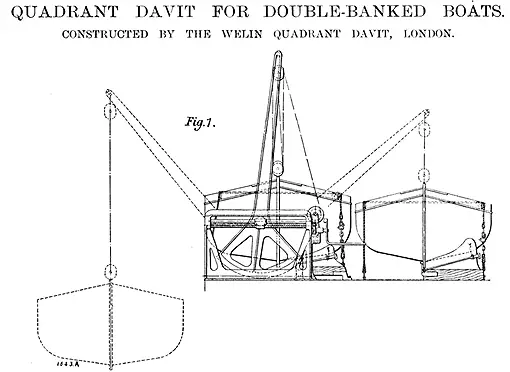
A diagram showing the working of the "Welin Quadrant Davit for Double-Banked Boats" printed in the Weekly Journal "Engineering", July 1, 1910.
At the US Inquiry he testified that the passengers were "Perfectly quiet and ready They could not have stood quieter if they had been in church. " and that he selected women and children passengers because of the "The rule of human nature" and also "by their sex... Excepting the stewardesses. We turned several of those away. " It seems he interpreted the "women and children first" as "women and children only" - even refusing stewardesses.
As to how Lightoller loaded passengers into the lifeboat, he wrote: “The practice was, to lower each boat until the gunwale was level with the boat deck, then, standing with one foot on the deck and one in the boat, the women just held out their right hand, the wrist of which I grabbed with my right hand, hooking my left arm underneath their arm, and so practically lifted them over the gap between the boat’s gunwale and the ship’s side, from the boat.”(47.)
At the US Inquiry he explained that he got in all of the lifeboats but then 'got out again' and "sometimes there would be three seamen in a boat. As soon as the boats were lowered to the level of the rail, I would detail one man to jump in and ship the rudder, one man to cast adrift the oars, and one man would see that the plugs were in, and it would take three men… Lowering it afterwards from the rail down. You see we have to swing it out first of all and lower it until it is level with the rail, so that the people can have one foot on deck and the other foot to step into the boat. They must be level."(25.)
When questioned at the US Inquiry about the lack of passengers in the lifeboats, Lightoller explained "with a brand new ship, and all brand new gear, brand new boats, and everything in the pink of condition, a boat might be safely lowered - you can not guarantee it - she might go down safely with perhaps 20 to 25 in her." Also he did not understand the urgency:
Senator SMITH. In a great emergency like that, where there were limited facilities, could you not have afforded to try to put more people into that boat?
Mr. LIGHTOLLER. I did not know it was urgent then. I had no idea it was urgent.
Senator SMITH. You did not know it was urgent.
Mr. LIGHTOLLER. Nothing like it.
Senator SMITH. Supposing you had known it was urgent, what would you have done?
Mr. LIGHTOLLER I would have acted to the best of my judgment then.
Senator SMITH. Tell me what you would have thought wise.
Mr. LIGHTOLLER. I would have taken more risks. I should not have considered it wise to put more in, but I might have taken risks... By the time I came to the third boat I was aware that it was getting serious, and then I started to take chances.(25.)
Possibly the reason that "by the time I came to the third boat I was aware that it was getting serious" is due to a means of measuring the sinking. In his book, he describes how he headed down a stairwell to C-Deck as he had done earlier that night in order to monitor how far the ship had descended into the ocean. “That cold, green water, crawling its ghostly way up that staircase, was a sight that stamped itself indelibly on my memory. Step by step, it made its way up, covering the electric lights, one after the other, which, for a time, shone under the surface, with horribly weird effect.”
Early in the evacuation he also removed his officer's great coat and wore a sweater: "I had long since discarded my great coat, even in pants and sweater over pyjamas alone I was in a bath of perspiration.” Which led to an alleged joke from the “junior surgeon” (Dr John Edward Simpson, Irishman, aged 37) who Lightoller described as “a noted wag—even in the face of tragedy, couldn’t resist his last mild joke, “Hello, Lights, are you warm?” The idea of anyone being warm in that temperature was a joke in itself, and I suppose it struck him as odd to meet me wearing a sweater.”(47.)
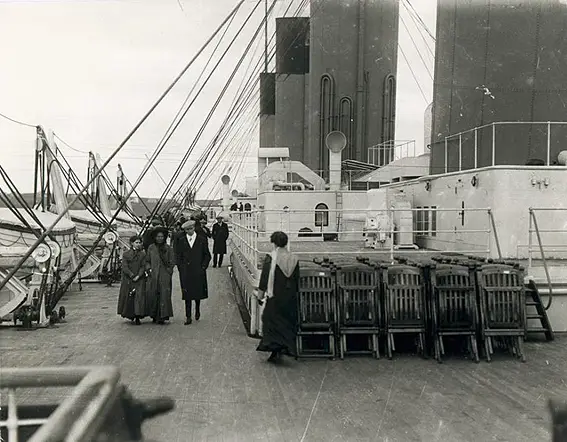
Titanic's port side boat deck, where Lightoller spent most of his time launching lifeboats.
Steam, orders and the lifeboat no.4 mistake
There is a large amount of confusion at the beginning of Lightoller's loading of the port side lifeboats. One reason for this is possibly due to the loud volume of steam that deafened everyone. Lightoller described the issue in his book: “The ship had been running under a big head of steam, therefore the instant the engines were stopped, the steam started roaring off at all eight exhausts, kicking up a row that would have dwarfed the row of a thousand railway engines thundering through a culvert.”(47.)
At the British Inquiry Lightoller described the beginning of his operation: "I began on the port side with the port forward boat. That would be No. 4…. I commenced stripping off No. 4; then two or three turned up; I told them off to No. 4 boat and stood off then myself and directed the men as they came up on deck, passing around the boat deck, round the various boats, and seeing that the men were evenly distributed around both the port and starboard... I could only direct them by motions of the hand. They could not hear what I said."(24.)
With the lifeboats now most ready, Lightoller first approaches Chief Officer Wilde. "I had finished seeing the men distributed round the deck, and the boat covers well under way and everything going smoothly, I then enquired of the Chief Officer whether we should carry on and swing out…I am under the impression that Mr. Wilde said “No,” or “Wait,” something to that effect….After I had swung out No. 4 boat I asked the Chief Officer should we put the women and children in, and he said “No.” I left the men to go ahead with their work and found the Commander" (British Inquiry (24.))
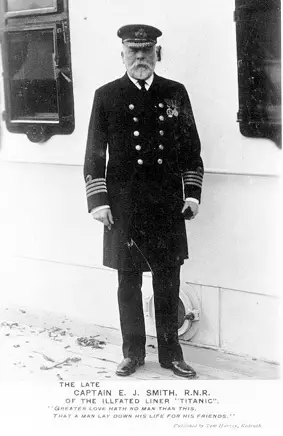
Captain Smith standing on Titanic's starboard
boat deck. (Click image to enlarge)
At around 12:22am Lightoller gets Captain's Smith approval to begin loading. At the British Inquiry he describes this moment: " I found the Commander, or I met him and I asked him should we put the women and children in, and the Commander said “Yes, put the women and children in and lower away.” That was the last order I received on the ship." (British Inquiry(24.)). His later description of this conversation has often led to the erroneous perception that the Captain was shell-shocked, as portrayed in films. In his book he describes his meeting with Smith on the boat deck during the time the steam was causing a loud volume of noise, this way: “ Drawing him into a corner, and cupping both my hands over my mouth and his ear, I yelled at the top of my voice, “Hadn’t we better get the women and children into the boats, sir?” He heard me, and nodded reply.”(47.)
According to the British Inquiry, lifeboat no.6 was the first to leave the port side. However in-depth research has revealed that the most likely first boat to be launched by Lightoller was actually no.8, at 1am (please note that the lifeboat launch timings are based upon the article The Lifeboat Launching Sequence Re-Examined by Bill Wormstedt, Tad Fitch and George Behe and the subsequent book Report into the SS Titanic: A Centennial Reappraisal (62.)).
The confusion is mostly due to the fact the first boat the Lightoller started loading was likely lifeboat no.4, which he had lowered to A deck prior to launching no.8 and no.6 (i.e. before 1am). This launch was postponed because Lightoller was unaware that the A deck glass windows actually blocked passengers from entering the boat there. The passengers were then sent back up to the Boat Deck. Some believe that it was Captain Smith's idea for the passengers to enter from the A deck. However. during the United State Inquiry Lightoller alluded to the issue with no.4 and took responsibility for it:
Mr. LIGHTOLLER. Previous to putting this Berthon boat out we had lowered a boat from A deck one deck down below. That was through my fault. It was the first boat I had lowered. I was intending to put the passengers in from A deck. On lowering it down I found the windows were closed. So I sent some one down to open the windows and carried on with the other boats, but decided it was not worth while lowering them down, that I could manage just as well from the boat deck. When I came forward from the other boats I loaded that boat from A deck by getting the women out through the windows. My idea in filling the boats there was because there was a wire hawser running along the side of the ship for coaling purposes, and it was handy to tie the boat in to, to hold it so that nobody could drop between the side of the boat and the ship.
Senator SMITH. Which one was that?
Mr. LIGHTOLLER. That is No. 4; No. 4 boat. (25.)
At the British Inquiry he added further detail to his mistake:
From the time we commenced to strip No. 4 boat cover until the time when we swung them out I should judge would be probably at most 15 or 20 minutes …Of course, there were the falls to coil down… I swung out No. 4 with the intention of loading all the boats from A deck, the next deck below the boat deck. I lowered No. 4 down to A deck, and gave orders for the women and children to go down to A deck to be loaded through the windows. My reason for loading the boats through the windows from A deck was that there was a coaling wire, a very strong wire running along A deck, and I thought it would be very useful to trice the boat to in case the ship got a slight list or anything; but as I was going down the ladder after giving the order, someone sung out and said the windows were up. I countermanded the order and told the people to come back on the boat deck and instructed two or three, I think they were stewards, to find the handles and lower the windows. That left No. 4 boat hanging at A deck, so then I went on to No. 6." (24.)
The result was a delay of half an hour from the time Captain Smith ordered the boats to be loaded with passengers before any of Lightoller's lifeboats were lowered while during the same period Murdoch had already launched three boats.
Gangway Doors - mistake no.2
In addition to loading from the A deck, Lightoller also planned to load more passengers after the lifeboats had been launched - via the gangway doors. He first mentioned it at the US Inquiry: "Earlier, and before I realized that there was any danger, I told off the boatswain to take some men - I didn't say how many, leaving the man to use his own judgment, to go down below and open the gangway doors in order that some boats could come alongside and be filled to their utmost capacity. He complied with the order, and, so far as I know, went down below, and I did not see him afterwards. That took away a number of men, and we detailed two men for each boat and two men for lowering down."(25.)
At the British Inquiry he also explained:
"I had already sent the boatswain and 6 men or told the boatswain to go down below and take some men with him and open the gangway doors with the intention of sending the boats to the gangway doors to be filled up. So with those considerations in mind I certainly should not have sent the boats away…. We should probably lower the rope ladder; that was our idea."(24.)
At the British Inquiry Lightoller also specifically identifies the gangway as being on "E deck." There was one key issue with this idea of using the gangway door and that is Lightoller seemed to forget to give any lifeboats the instruction to go there to collect more passengers. At the British Inquiry he continues:
The Commissioner: Did you give any directions (I think you said you did not remember) to the boats to remain about the gangway door?
Lightoller - No, my Lord.
The Commissioner: You did not?
Lightoller - Not that I remember.
The Commissioner: You do not remember?
Lightoller- Not that I remember.
The Commissioner: Would they then know that those gangway doors would be open - would the men in the boat know that those gangway doors would be open?
Lightoller- Hanging about the ship they could not very well fail to see if the gangway doors were open - the light shining through, the blaze of lights; and they would very soon be hailed by people at the gangway doors. The boatswain was down there. He has to use a little common sense as well, and when he has opened the gangway door he would naturally hail a boat, and tell them “starboard gangway door open,” “the port gangway door open,” and so let them know. On a calm night like that your Lordship will know the voice will carry a long way. (British Inquiry(24.))
Captain Smith was also unaware of Lightoller's gangway door plan:
"I heard the Commander two or three times hail through the megaphone to bring the boats alongside, and I presumed he was alluding to the gangway doors, giving orders to the boats to go to the gangway doors… During the time I was launching the boats on the port side, I could not give you any definite time….He did not know about my order about the gangway doors.… I had not discussed the matter with the Captain… It came to both our minds and naturally anyone familiar with the ship, any seaman, any one attached to the ship, would know at once that was the best means of putting the people into the boat - by the gangway doors." (British Inquiry(24.))
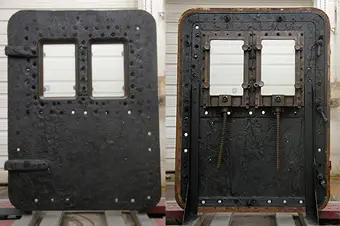
Port-side gangway door from the Titanic’s D-Deck
recovered from the wreck site. Image: Evergreene.com
(Click image to enlarge) (49.)
In his book he added further details to this instruction: "I told the Bosun’s Mate to take six hands and open the port lower-deck gangway door, which was abreast of No. 2 hatch. He took his men and proceeded to carry out the order, but neither he or the men were seen again. One can only suppose that they gave their lives endeavouring to carry out this order, probably they were trapped in the alley-way by a rush of water, but by this time the fo’c’sle head was within about ten feet of the water."(47.)
Perhaps Lightoller had good reasons for trying to load more people via the gangway door (he was referring to the doors on E deck, however it could have been the doors on D deck, that have been recovered from the wreck). Interesting, no one aboard Lifeboat No. 6, which passed directly in front of the gangway door on D deck when lowered, mentioned it being open with crew and passengers waiting there. Some researchers believe that once water began entering the ship via this gangway door it helped balance the starboard list, or worse, added to how quickly the Titanic sank. It is possible that Fourth Officer Boxhall's boat actually did make it to the door, but years after the disaster in 1962 in a BBC radio interview he admitted to backing away, fearing getting swamped by the crowd of people waiting there. However, if the accuracy of his later memory can be relied upon, he is likely referencing the starboard gangway door.
1:00am Lifeboat no. 8
The first lifeboat that Lightoller successfully loaded and lowered into the water was no.8. Captain Smith is seen by many crew and passengers including first class steward Alfred Crawford and Countess of Rothes and her maid Roberta Maioni helping with the loading of lifeboat no.8.
According to the New York Herald, Friday, April 19, 1912 Mrs Swift, a lifeboat occupant, reported:
'There were twenty-two persons, including three seamen and a steward, aboard our boat, and as we were suspended over the water far below, Captain Smith tucked a loaf of bread in the bow, where there were two casks of water....Slowly we dropped down, down and down until the keel of our tiny craft struck the sea and the captain shouted to pull over to a red light in the distance...we also began to realize that the seamen were not oarsmen. One was unable to pull the long heavy oar with any strength and Mrs. Swift took his place....the weak and unskilled steward and some of the other men sat quietly in one end of the boat. The countess of Rothes was an expert oarswoman.'
One occupant of lifeboat number 8 was socialite Ella White who used a walking stick, with a built in electric light. Lightoller writes:
“One very good lady who achieved fame by waving an electric light and successfully blinding us as we worked on the boats. It puzzled me until I found she had it installed in the head of her walking stick! I am afraid she was rather disappointed on finding out that her precious light was not a bit appreciated. Arriving in safety on board the Carpathia, she tried to make out that someone had stolen her wretched stick, whereas it had been merely taken from her, in response to my request that someone would throw the damn thing overboard.”(47.)
According to the book A Night To Remember (R & W Holt, 1955) by Walter Lord., "Mrs. J. Stuart (Ella) White didn't help row No. 8, but she appointed herself a sort of signalman. She had a cane with a built-in electric light, and during most of the night she waved it fiercely about attempting to signal rescue ships."
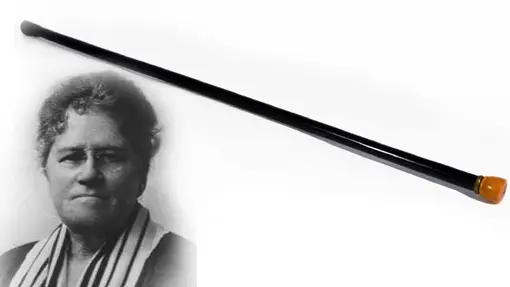
Mrs. Stuart (Ella) White and her 'flashlight' cane, which Lightoller did not appreciate, requesting that someone "would throw the damn thing overboard." The cane was up for auction in 2019 and expected to reach $500,000 it actually sold for $62,500 (courtesy of liveauctioneers.com).
Lifeboat 8 was eventually launched at 1am with only 25 occupants and AB Seaman Thomas Jones in charge.(62.)
1:10 Lifeboat no. 6 and the Mystery ship
Captain Smith was once again seen by passengers helping with loading of no.6 and using a megaphone to urge "Women and children first." Lightoller also heard the orchestra play during the loading of this boat and wrote in his book: "Passing along to No 6 boat to load and lower, I could hear the band playing cheery sort of music. I don’t like jazz music as a rule, but I was glad to hear it that night. I think it helped us all.”(47.)
There was a lack of passengers, possibly due to confusion over where to assemble after lifeboat no.4 had been lowered incorrectly to A deck. Some ladies were, however, persuaded to enter; Mrs. Rothschild and others stepped in, finally. Mrs. Margaret Brown stated she was more or less thrown into it when it was about to be lowered away. In the end there were no more than 24 people in the boat when it was loaded.
Part of the reluctance and hence low lifeboat numbers could well have been caused by Lightoller. In his book he wrote:
“On the Titanic passengers naturally kept coming up and asking, did I consider the situation serious. In all cases I tried to cheer them up, by telling them “No,” but that it was a matter of precaution to get the boats in the water, ready for any emergency. That in any case that they were perfectly safe, as there was a ship not more than a few miles away, and I pointed out the lights on the port bow which they could see as well as I could.”(47.)
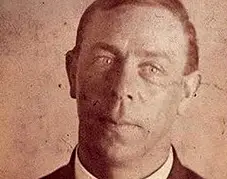
Quartermaster Robert Hichins was
put in charge of lifeboat 6
And there was also a lack of crew. After being ordered into no.6, Lamptrimmer Samuel Hemming subsequently stepped back onboard the ship to man one of the aft falls for this boat. Additionally, Lightoller had sent Boatswain Alfred Nichols and six other men below to open the gangway doors. The intention was to bring lifeboats alongside the ship and take on more passengers there once afloat. The men never returned from below, and from then on, Lightoller was short on trained seamen. Lightoller put quartermaster Robert Hichens in charge of no.6 and ordered Lookout Frederick Fleet aboard as well. But as it was being lowered it was realised that there were only 2 sailors to man the boat, so Lightoller ordered Major Arthur Peuchen to climb down the falls and into the lifeboat.
When asked at the British Inquiry whether Lightoller gave "any order or direction to the man in charge of boat No. 6 that he was to keep near or was to go to the gangway doors?" he replied "Not that I remember. The boats would naturally remain within hail."(24.)
Instead, according to Lookout Frederick Fleet at the US Inquiry, lifeboat no.6 was ordered to row to a "A bright light on the port bow… It did not seem to be moving at all... Mr. Lightoller, when I got into the boat made us pull straight for it... Mr. Lightoller made us pull toward it. He seen it as well as us." (25.)
However Lightoller does not remember this. At the British Inquiry he was asked if he gave "any further order to that boat, No. 6, as to what it was to do or where it was to go?" and he replied "Not that I remember. I knew there was, if I may mention it, this light on the port bow about two points; I had already been calling many of the passengers’ attention to it, pointing it out to them and saying there was a ship over there, that probably it was a sailing ship as she did not appear to come any closer, and that at daylight very likely a breeze would spring up and she would come in and pick us up out of the boats, and generally reassuring them by pointing out the light; but whether I told them to pull towards the light I really could not say. I might have done and I might not."(24.)
At the US Inquiry, Lightoller described the light as being "two points on the port bow... Four or 5 miles away. I would say 3 to 4 miles, roughly. I did not stop to look at them... I do not know how the ship was heading then." (25.) At the British Inquiry he added "I can recollect seeing it for about half an hour" and that there was not any field ice or pack ice about the Titanic that would prevent the ship coming to their rescue. (24.)
Later Lightoller writes in his book with anger and frustration about the Californian’s lack of response even suggesting “what wouldn’t I have given for a six inch gun and a couple of shells to wake them up.” Lightoller believes the Californian could have saved everyone…. “And what an absolutely unique opportunity Captain Lord of the Californian had that night of rendering aid and saving close on 1,500 lives. Nothing could have been easier than to have laid his ship actually alongside the Titanic and taken every soul on board. Yet, not a thing was done, not even their wireless operator roused to see if there were any distress calls.”(47.)
Lifeboat number 6 was launched with only 24 occupants in total at 1:10am and quartermaster Robert Hichens in charge.
1:15am Guns Issued and Lightoller's lifebelt
By now, with more passengers realising Titanic’s demise and the limited number of lifeboat seats, crowd control becomes an issue. General consensus places the time at around 1:15am when the senior officers make the decision to have revolvers at the ready in case the crowds begin to rush the boats. Lightoller describes the moment in his book:
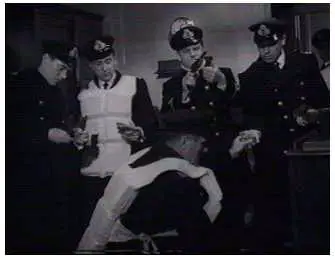
Guns handed out to officers in Murdoch's cabin as
portrayed in the film "A Night to Remember" (1958)
The Chief Officer came over from the starboard side and asked, did I know where the firearms were?
As I pointed out before, it was the First Officer’s responsibility to receive firearms, navigation instruments, and so forth. I have also said firearms on merchant ships are looked on as ornamental more than useful, and as First Officer I had simply hove the lot into a locker, in my original cabin, a locker that was of little use owing to its inaccessibility.
Then, later on, had come the “general post,” whereby Murdoch who was now First Officer, knew nothing about the firearms, and couldn’t find them when they were wanted—I say wanted, rather than needed, because I still don’t believe they were actually needed.
I told the Chief Officer, “Yes, I know where they are. Come along and I’ll get them for you,” and into the First Officer’s cabin we went—the Chief, Murdoch, the Captain and myself—where I hauled them out, still in all their pristine newness and grease.
I was going out when the Chief shoved one of the revolvers into my hands, with a handful of ammunition, and said, “Here you are, you may need it.” On the impulse, I just slipped it into my pocket, along with the cartridges, and returned to the boats. The whole incident had not taken more than three minutes, though it seemed barely worth that precious time.(47.)
Later in October 1912 Lightoller also recalled this moment, in an article for the Christian Science Sentinel, in which he attributes his survival to faith and in doing so mysteriously calls the guns "articles" rather than what he was really obtaining from the first officer's cabin, but also mentions retrieving his life-belt:
Now it will be seen why it was that Wilde, on wanting some articles which were received by the first officer in Belfast, came to me. I took him into the first officer's room and showed him where they were, and was on my way back on deck again when I heard Wilde say, 'I am going to put on my life-belt.' At that precise moment I was passing my own room door, facing which is a wardrobe, and on the top of this was my own life-belt. On hearing Wilde's remark, I instinctively looked into the room, reached for the belt, and put it on.
1:20am Lifeboat No. 16
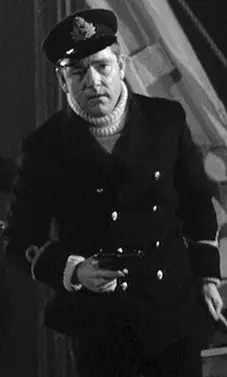
Lightoller, played by Kenneth More,
portrayed with a gun in the 1958
film "A Night to Remember".
Interestingly, immediately after Lightoller, Wilde and Murdoch retrieved the guns, there is a report of one during the loading of Lightoller's next lifeboat - number 16, which was launched under the supervision of Sixth officer Moody. A large crowd of passengers had collected in this area and officers Wilde, Lightoller, Lowe and Moody were all involved in controlling the crowd.(62.)
"Also, Mrs Elizabeth Anne Wilkinson, a second class passenger, mentioned similar: When she rushed upon deck she was ordered into a lifeboat, but feared to trust herself in one of the frail craft. While officers with drawn revolvers issued their orders, one of the men, she says, forced her bodily into the second boat..." (The Evening Telegraph, April 26, 1912).
Another second class passenger in number 16, Miss Edwina "Winnie" Troutt reported:
"In my boat," she said, "there were 20 women, not less than a dozen babies, and five members of the crew in charge of Master-at-Arms Bailey. One of these women was Mrs. Harry Faunthorpe, a bride. She was an Englishwoman who had been married in January. With her husband she was making a pleasure trip to California. Her husband bade her good-bye with a smile and a pat of encouragement and placed her in the boat. As she stepped in I called to her husband and asked him to take my seat. But he merely laughed and replied: Remember. I am an Englishman..." - Boston Herald, 26 May, 1912
Launched at 1:20am with Master at Arms Bailey in charge, it had 52 occupants aboard - the most of any lifeboats launched by Lightoller.
1:25 Lifeboat no.14
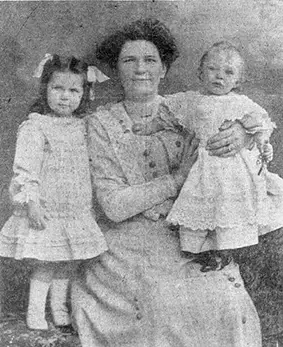
Mrs Addie Wells with her children Joan and
Ralph, said she "I "saw a revolver in an
officer's hand."
The second boat lowered after Lightoller retrieved his gun also has a report about guns. Mrs. Addie Wells, a second class passenger who survived in lifeboat 14 reported the following:
An officer was shouting, "'Come on here, lively now, this way, women and children' and before I knew what was happening we were in a lifeboat, and the boat was going down the side while the men stood back serious and sober, watching us. "I thought even then it was some sort of a drill or something, except that just as we went down I saw a revolver in an officer's hand…A Mrs. Davis and a little boy were in the boat with us, and she asked me what it was all about. "As soon as the boat struck water, the seaman began pulling away with all their might. As we got away, we saw a lot of wild eyed men come rushing up from steerage, but they were met by a man with a gun who pushed them back into a crowd of men and said, "Stand back there now, the first word out of you and I'll ----" I didn't catch the rest." (Akron Beacon Journal, April 20, 1912)
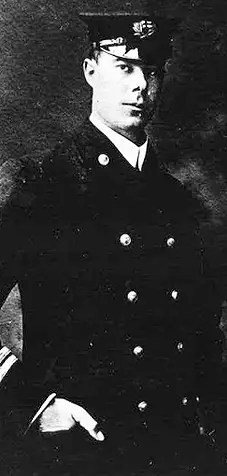
Fifth Officer Lowe was put in charge
of Lifeboat 14.
According to Mrs Agnes Davies, a second class passenger who survived in lifeboat 14, she was allowed in with her 8 year old son, John Morgan Davies Jnr, but her 19 year old son Joseph was refused. She explains:
"My older son, Joseph, helped to place us in the boat and asked permission to enter it himself, this being refused with the threat that he would be shot if he attempted to get in. I pleaded with the officers in vain, that he be allowed to come with me. There were about fifty in the boat, but there was room for more." (Calumet newspaper, Michigan, April 1912)
Lightoller put Fifth Officer Lowe in charge of this boat, with about 40 in total when lowered. The reason for a disturbance at this lifeboat is possibly due to a rumour. "A rumour that men were going to be taken off on the aft port side had been spread, resulting in the aft starboard side being left almost deserted, as noted by second class passenger Lawrence Beesley. Many of the officers and crew subsequently headed to the aft port side of the boat deck to calm the disorder which culminated with warning shots being fired at no.14." (62.)
Lowe thought that the crowd was becoming unruly and men threatened to jump into it, so as a matter of precaution, he fired a few times in the air with his gun when the boat was lowered away. When No. 14 was near the water, there was an issue and the boat dropped three or four feet, which apparently led to the boat springing a leak and water started pouring into it, and some women had to deal with the problem.
1:30am Lifeboat no.12
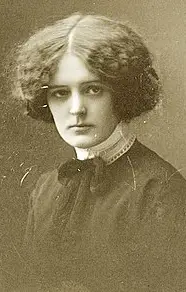
Miss Dagmar Bryhl's fiancé
and brother were refused entry
into lifeboat 12.
Swedish second class passenger, Miss Dagmar Bryhl reported trying to get the officer in charge to let her brother and fiancé to come with her into the boat: "When Miss Bryhl hear the order that only women were to be allowed in the lifeboats she seized her sweetheart and begged that both her and her brother, who stood by her side would be allowed in the lifeboat. She clung to the young men, begging and pleading that as the boat was only half full, they be allowed to enter the lifeboat, but they were torn from her side and the last she knows of them they were standing on deck, bidding her be of good cheer." (Rockford Daily Register Gazette, Thursday 25th April 1912)
In evidence given at the British Inquiry, 27 year old Able Seaman John Poingdestre also referenced Lightoller's misunderstanding of the lifeboat capacity in regards to lifeboat 12:
2958. Do you know how it comes that there were not more than 42 put into this boat?
JOHN POINGDESTRE A.B.Yes.
2959. Why?
JOHN POINGDESTRE A.B. - Well the reason is that the falls would not carry any more.
2960. You mean somebody was frightened of the falls?
JOHN POINGDESTRE A.B. Yes, the second officer, Mr. Lightoller.
2961. Now having lowered her down to the water did Mr. Lightoller give you any orders as to what to do with the boat?
JOHN POINGDESTRE A.B. He gave me orders before the boat was lowered what to do.
2962. What orders did he give you?
JOHN POINGDESTRE A.B. To lay off and stand by close to the ship...
3130. Were there any others on the deck at the time?
JOHN POINGDESTRE A.B. No, only the two men that were lowering the boat.
3131. Now you stated that Mr. Lightoller warned you that the falls might give way?
JOHN POINGDESTRE A.B. Yes...
3203. You subsequently returned?
JOHN POINGDESTRE A.B.- I was ordered out of the boat by Mr. Lightoller.
3204. Did you go?
JOHN POINGDESTRE A.B. - Yes.
3205. Did you subsequently return?
JOHN POINGDESTRE A.B. I said to Mr. Lightoller, “There is no seaman in that boat.” He said “all right, go back again.”
3307. When Mr. Lightoller told you about the falls not being strong enough was that when the boat was being rushed?
JOHN POINGDESTRE A.B.Yes; the boat was already full.
3308. (The Commissioner.) No. How many were in the boat? -
JOHN POINGDESTRE A.B. There were 40 in the boat, but the falls would not take any more.
The Commissioner: Well, that is what Mr. Lightoller said. Apparently the falls had taken more in the other boats.
3309. (Mr. Laing.) When Mr. Lightoller said that was the boat being rushed or were they trying to rush the boat?
JOHN POINGDESTRE A.B. They were trying to rush the boat.
3310. Afterwards he told you to lower away?
JOHN POINGDESTRE A.B.Well, he did not tell me, he told the other two men.
Lifeboat 12 was launched at 1:30am with 42 onboard and AB John Poingdestre in charge.
1:45 Distress Rockets, Lifeboat no.2 and Lightoller's gun
Fourth Officer Boxhall was sent in charge of this boat. Up until this time Boxhall had been in charge of firing the distress signals, which Lightoller describes in detail at the British Inquiry:
Solicitor-General: What sort of light do they show?
Lightoller: A shell bursts at a great height in the air, throwing out a great number of stars.
Solicitor-General: . What is the colour?
Lightoller: Principally white, almost white.
Solicitor-General: How are they discharged; are they discharged from a socket?
Lightoller: In the first place, the charge is no more and no less than what you would use in a 12-pounder or something like that. In the rail is a gunmetal socket. In the base of this cartridge, you may call it, is a black powder charge. The hole down through the centre of the remainder is blocked up with a peg. You insert the cartridge in this socket; a brass detonator, which reaches from the top of the signal into the charge at the base, is then inserted in this hole. There is a wire running through this detonator, and the pulling of this wire fires that, and that, in turn, fires the charge at the base of the cartridge. That, exploding, throws the shell to a height of several hundred feet, which is nothing more or less than a time shell and explodes by time in the air.…I should roughly estimate somewhere about eight at intervals of a few minutes - five or six minutes, or something like that.
Solicitor-General: One at a time?
Lightoller: Yes, all fired from the starboard side, as far as I know...
Solicitor-General: You had a Morse apparatus on your ship?
Lightoller: One on each side.
Solicitor-General: For sending signals by flash?
Lightoller: Exactly.
Solicitor-General: . Was that made use of?
Lightoller: It was on the port side.(24.)
The Morse code on the portside must have been for attempting to contact the mystery light on the horizon.
According to the British Board of Trade inquiry, Lightoller had nothing to do with the lowering of no.2:
13988. Had you had nothing to do with that No. 2 boat going? - Nothing.
13989. And you know nothing about that boat? - I know nothing about that boat.
However in his book he describes using his unloaded gun at no.2:
“Arriving alongside the emergency boat, someone spoke out of the darkness, and said, “There are men in that boat.” I jumped in, and regret to say that there actually were—but they weren’t British, nor of the English speaking race. I won’t even attribute any nationality to them, beyond saying that they come under the broad category known to sailors as “Dagoes.” They hopped out mighty quickly, and I encouraged them verbally, also by vigorously flourishing my revolver. They certainly thought they were between the devil and the deep sea in more senses than one, and I had the satisfaction of seeing them tumbling head over heels on to the deck, preferring the uncertain safety of the deck, to the cold lead, which I suppose they fully imagined would follow their disobedience—so much for imagination—the revolver was not even loaded!”(47.)
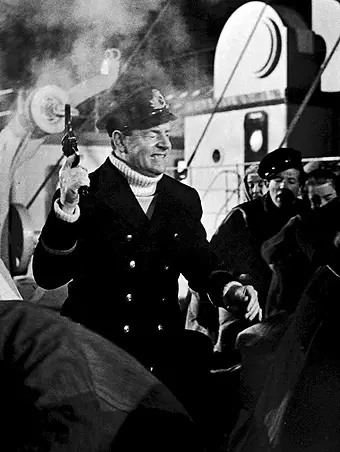
Lightoller as portrayed by Kenneth More 1958 film
"A Night to Remember" firing his gun.
He describes the boat as the "emergency boat", which would seem to indicate it is no.2, as Titanic had two emergency cutters with a capacity of 40 each, numbered 1 and 2, which were often seen swung out on the port and starboard sides of the ship. But there is a possibility he is referring to collapsible D.
In private, Lightoller actually mentioned firing his gun. During the US Inquiry Colonel Archibald Gracie testified that Lightoller told him directly about using it during the evacuation.
As to what happened on the other side during our departure, the information I was given by the second officer was that some of the steerage passengers tried to rush the boat, and he fired off a pistol to make them get out, and they did get out.
Senator SMITH. Who fired that pistol?
Mr. GRACIE. Lightoller. That is what he told me. He is the second officer... That is what Mr. Lightoller himself told me. I did not hear the pistol. That is what I was told by Lightoller himself…I want to say that there was nothing but the most heroic conduct on the part of all men and women at that time, where I was at the bow on the port side. There was no man who asked to get in a boat, with the single exception that I have already mentioned. No woman even sobbed or wrung her hands, and everything appeared perfectly orderly.(25.)
It is unfortunate that Senator Smith never picked up on this and ask Lightoller directly about shooting his gun. Nonetheless, Gracie also describes Ligtholler's behaviour at the time:
Lightoller was splendid in his conduct with the crew, and the crew did their duty. It seemed to me it was rather a little bit more difficult than it should have been to launch the boats alongside the ship. I do not know the cause of that. I do not know whether it was on account of the newness of it all, the painting, or something of that sort. I know I had to use my muscle as best I could in trying to push those boats so as to get them over the gunwale.(25.)
At 1:45am Captain Smith shouts to Boxhall while lifeboat no.2 is being lowered to take his boat round to the starboard gangway hatch and load more passengers from there.
1:50am Lifeboats 10 and 4
It now seems reasonably certain that at this point in the proceedings, with only the two collapsibles left on the starboard side, that First Officer Murdoch crosses over to the port side to check on progress and assists with the loading of lifeboat no.10.
At the same time Lightoller is working on no.4 - the lifeboat he had first started working on at least an hour before the boat having been erroneously lowered from the boat deck to A deck. After sending two stewards below to find the window cranks to open the windows Lightoller had abandoned no.4 and moved aft to work on boats 6 and 8.
At the British Inquiry he describes the moment:
Returning forward, down on to A deck. The windows were down. I placed some chairs against the window and formed a step, and standing outside myself, the same order was proceeded with, except that the boat was triced right close into the wire… and make it fast right into the wire... I was able to stand with one foot on the ship and one foot on the boat.(24.)
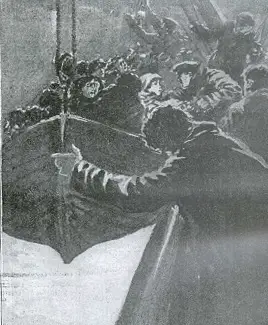
The L'Excelsior newspaper of Saturday 20th
April 1912 portrays Astor saying goodbye
as lifeboat no.4 is lowered saying
"We'll meet in New York."
There were some famous names in this boat: the Astors, the Carters, the Wideners and the Thayers. Despite the fame, Lightoller was still being very strict.
Even as the boats were loaded Astor appeared unperturbed, he ridiculed the idea of trading the solid decks of the Titanic for a small lifeboat 'we are safer here than in that little boat'. He had changed his mind by 1:45am when Second Officer Charles Lightoller arrived on A deck to finish loading Lifeboat 4. Astor helped his wife to climb through the windows of the enclosed promenade and then asked if he might join her, being as she was in 'a delicate condition'. Lightoller told him that no men could enter until all the women had been loaded. Astor stood back and just asked Lightoller which boat it was. After boat 4 was lowered at 1:55am Astor stood alone while others tried to free the remaining collapsible boats. Allegedly, Astor tells his young wife: "We'll meet in New York."
Even so lifeboat number 4, with Quartermaster Walter Perkis in charge, had only 30 occupants when it was finally lowered at 1:50am.
2:05am Collapsible D - "The Last Boat"
Lightoller next starts working on collapsible D, using the now empty davits and rope falls that had been used for no2.. At the British Inquiry he described the process: "The tackles were already rounded up when I got on the boat deck; we lifted the gunwale of the boat, which opens it up, hooked on the tackles, put it over the side; Mr. Wilde was there too at this time.(24.)
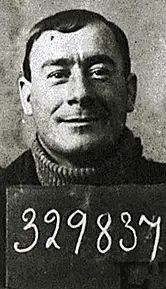
William Lucas AB testified
that ten minutes was lost
looking for a plug for
collapsible D, although
collapsibles do not have plugs.
At the British Inquiry William Lucas AB mentioned there was a problem with the plug in the collapsible lifeboat which also prevented them for lowering it with a full load. He testified "Well, we were frightened of her ourselves. Mr. Lightoller gave orders, “Keep quiet, men, before you get into the boat now... We did not know whether there was a plug in it or not. We could not find it. There was water under our feet. The women were frightened of her. These boats have a false bottom and plug hole about that depth. Me and Mr. Lightoller were looking round for that plug a good ten minutes before any passenger got into it and could not find it."(24.)
Lightoller also mentioned a problem with the plug: "When we were at work at the port collapsible boat, the first collapsible, it was suggested that there was a plug in the boat, and not being very familiar with these boats and having a box of matches, I searched round and came to the conclusion there was no plug." (British Inquiry(24.)) As the collapsibles had no plugs his search was in vain, and just added to further wasting of time.
However, Lightoller said that he also had difficulty getting enough for this boat.
We had very great difficulty in filling her with women. As far as I remember she was eventually filled, but we experienced considerable difficulty. Two or three times we had to wait, and call out for women - in fact, I think on one - perhaps two - occasions, someone standing close to the boat said, “Oh, there are no more women,” and with that several men commenced to climb in. Just then, or a moment afterwards, whilst they were still climbing in, someone sang out on the deck, “Here are a couple more.” Naturally, I judged they were women ...and the men got out of the boat again... I believe it was a new boat, where a couple of Phillipinos or Chinese got in; they stowed away under the thwarts or something. But for that there were no men except crew - except the men I ordered in.. I am under the impression that I could have put more in that boat and could have put some men in, but I did not feel justified in giving an order for men to get into the boat, as it was the last boat as far as I knew leaving the ship, and I thought it better to get her into the water safely with the number she had in; or, in other words, I did not want the boat to be rushed (British Inquiry(24.)).
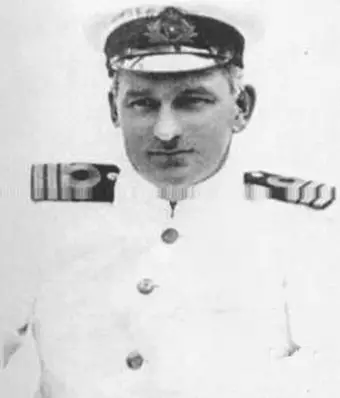
Chief Officer Henry Wilde - Lightoller refused his order
to take command of the lifeboat.
It was here that Chief Officer Wilde told Lightoller to get in as well (although some suggest it was lifeboat 2 that this happened), but the Second Officer refused: “I stood partly in the boat, owing to the difficulty of getting the womenfolk over a high bulwark rail just here. As we were ready for lowering the Chief came over to my side of the deck and, seeing me in the boat and no seaman available said, “You go with her, Lightoller.” Praises be, I had just sufficient sense to say, ‘Not damn likely,’ and jump back on board, not with any sense of self-martyrdom –far from it –it was just pure impulse of the moment, and an impulse for which I was to thank my lucky stars a thousand times over, in the days to come. I had taken my chance and gone down with the rest; consequently I didn’t have to take any old back-chat from anyone.” (Lightoller's book(47.))
At the US Inquiry 2nd Class Chief Steward John Hardy mentions Lightoller and Wilde at the collapsible:
By that time all the starboard boats had gone, and I went over to the port side and assisted the ladies and children in getting into the boats, and finally I was working on deck until the last collapsible boat was launched…. Right forward, on the port side. We launched this filled with passengers. We launched the boat parallel with the ship's side, and Mr. Lightoller and myself, two sailors, and two firemen - the two sailors were rigging the poles and getting them in working order and Mr. Lightoller and myself loaded the boat. When the boat was full, Mr. Lightoller was in the boat with me; and the chief officer came along and asked if the boat was full, and he said yes. He said he would step out himself and make room for somebody else, and he stepped back on board the ship and asked if I could row. I told him I could, and I went away in that boat. We lowered away and got to the water, and the ship was then at a heavy list to port by the time we commenced to lower away.(25.)
Lightoller noting the list to port at this time, with Wilde being present, is likely when the Chief Officer made passengers move to the starboard side which would have also caused an issue with the number of passengers available for loading. At the US Inquiry Lightoller said: "When the ship was taking a heavy list - not a heavy list - but she was taking a list over to port, the order was called, I think, by the chief officer. "Everyone on the starboard side to straighten her up," which I repeated." (US Inquiry(25.))
As collapsible D was lowered men jumped into the boat. In his book he wrote: ”As this boat was being lowered, two men passengers jumped into her from the deck below. This, as far as I know was the only instance of men getting away in boats from the port side. I don’t blame them, the boat wasn’t full, for the simple reason that we couldn’t find sufficient women, and there was no time to wait—the water was then actually lapping round their feet on “A” deck, so they jumped for it and got away. Good luck to them.”(47.)
At the British Inquiry Lightoller also mentioned the water level: "Almost immediately afterwards the water came from the stairway. There is a little stairway goes down here just abaft the bridge, which goes right down here and comes out on this deck for the use of the crew only and it was almost immediately after that the water came up that stairway on to the boat deck."(24.)
The step measurement was also mentioned in his BBC radio broadcast in 1936:
Now between lowering one boat and another, I frequently took a run forward and a quick look down a long stairway that led from the boat deck three or four decks down. Frankly, I'm never likely to forget the sight of that cold greenish water creeping step by step up that stairway. Some of the lights were shining down on the water and others already submerged were giving it a sort of ghastly transparency. But for my purpose I could tell by that staircase measurement exactly what was happening, how far down she'd gone and how quickly she was going.
As the last boat (other than the collapsibles stored on the roof) a crowd formed Wilde and Lightoller had the crew link arms to stop a rush and allow only women and children through. According to Gracie's testimony, Lightoller told him that he had been forced to fire a pistol to stop men rushing the boat. However by 1913 when Gracie's book was released he changed his story to only brandishing a gun. D was finally launched at 2:05am, with only 20 aboard and Quartermaster Arthur Bright in charge.(62.)
Good Bye to Doctors and Pursers
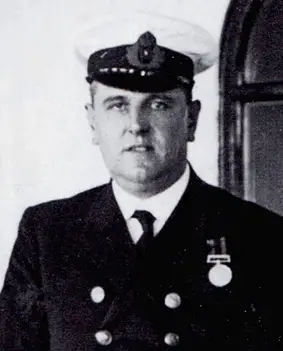
Lightoller remembers seeing Chief Purser Hugh
McElroy "walking around with his hands in
his pockets".
Lightoller describes meeting “Purser, Assistant Purser, and the Senior and Junior surgeons” (Hugh McElroy, Reginald Barker, O’Loughlin, Simpson) as saying goodbye to them when the water was at C deck. And about this time also meeting all the engineers, as they came trooping up from below. "Most of them I knew individually, and had been shipmates with them on different ships of the Line….There was little opportunity to say more than a word or two to the engineers. Up to that time they had known little of what was going on, and it was surely a bleak and hopeless spectacle that met their eyes. Empty falls hanging loosely from every davit head, and not a solitary hope for any of them. In point of fact, they were lost to a man, not one single survivor out of the whole thirty-five.”(47.)
At the US Inquiry he also stated:
"The purser - as a matter of fact, both the pursers - and the pursers' assistants, of whom I believe there were four - two pursers and four assistants, and two doctors, were there. Both pursers I was very friendly with, and knew them both intimately, ashore and afloat. They were both thoroughly capable men. I draw the conclusion that everyone was notified, by the manner and under the circumstances under which I met them last. It was obvious to me that everything with regard to their duty had been done by the mere fact that shortly before the vessel sank I met a purser, Mr. McElroy, Mr. Barker, Dr. O'Loughlin, and Dr: Simpson, and the four assistants. They were just coming from the direction of the bridge. They were evidently just keeping out of everybody's way. They were keeping away from the crowd so as not to interfere with the loading of the boats. McElroy, if I remember, was walking around with his hands in his pockets. The purser's assistant was coming behind with the ship's bag, showing that all detail work had been attended to. I think one of them had a roll of papers under his arm, showing that they had been attending to their detail work. That is why I draw the conclusion. They were perfectly quiet. They came up to me and just shook hands and said, "Good-bye, old man." said good-bye to each other, and that is all there was to it."(25.)

Titanic's Dr Simpson - Lightoller wrote they
said "Goodbye, old man"
None of the pursers, as described by Lightoller, entered a lifeboat; they all died. In fact later on the 1st of May 1912 he wrote a letter to a Mr R.W. Graham, stating:
"I may say I was practically the last man to speak to Dr Simpson, and on this occasion he was walking along the boat deck in company with Mssrs. McElroy, Barker, Dr O'Loughlin and four assistant pursers. They were all perfectly calm in the knowledge that they had done their duty and were still assisting by showing a calm and cool exterior to the passengers. Each one individually came up to me and shook hands. We merely exchanged the words 'Goodbye, old man'. This occurred shortly before the end and I am not aware that he was seen by anyone after. With deepest sympathy for you in the loss of your friend."